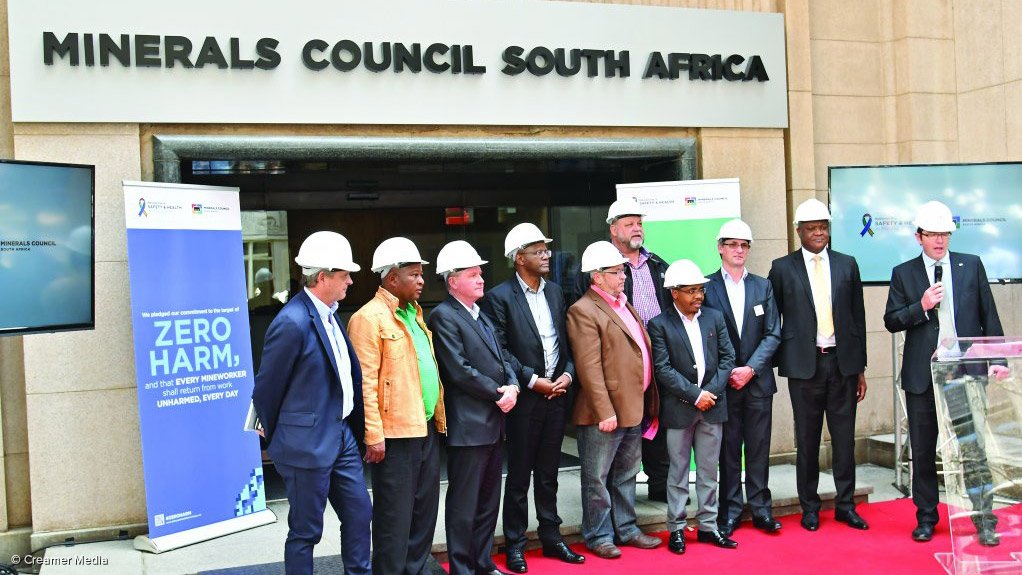Minerals Council South Africa – formerly known as the Chamber of Mines – officially rebranded in May 2018, repositioning the organisation to reflect “the promise of the future” by amending its role and ethos to drive a positive reform agenda that enables the industry to reach its true economic and transformation potential, says Minerals Council CEO Roger Baxter.
He explains that the rebranding was a signal that the industry is “moving forward, building a new legacy and creating a future all South Africans can be proud of”.
To that end, the Minerals Council has introduced the credo of – #MakeMiningMatter – which encompasses its objectives and values.
The organisation has internalised its message, with Minerals Council administration head Jeannette Hofsajer introducing several initiatives to modernise the building and administrative processes, including a rooftop garden, an atmospheric water generator and energy efficient systems.
One of the key roles for the Minerals Council is to “help drive South Africa’s competitiveness ranking”, says Baxter, adding that the country is still in the bottom half of the Fraser Institute’s investment attractiveness ranking, despite the fact that it is ranked in the top quartile in terms of mineral wealth.
He comments that the Leadership Compact – signed at the Investing in African Mining Indaba earlier this year – was a significant step towards realising the joint vision of a “competitive, growing, transformed, safe, community- developing, mining industry”.
Baxter says an issue that needs to be resolved is the establishment of “policy that is certain, predictable and competitive”. He adds that the industry needs less red tape and more “smart tape”, with the Minerals Council, for example, investigating the viability of a minerals commission that independently administers mining and prospecting rights applications.
“We need a long-term pricing trajectory for key inputs such as electricity and water, a 20-year view. We also need greater private sector participation in rail, ports, and electricity to unlock the huge amount of economic potential,” thereby stimulating economic growth and job creation. How can mining companies approve new energy intensive projects while there are remaining uncertainties on the carbon tax implementation post 2023 and where there is no visibility of the likely electricity pricing trajectory over the next decade or two. These are key issues that need to be resolved to create greater certainty for new investment.
He states that the 523% increase in electricity prices for large industrial customers over the last ten years is a deal breaker. He adds that the industry is paying more in Rand terms than the average of its American and Canadian counterparts – Quebec is R0,65/kWh, the USA’s average is R1,00/kWh compared to R1.06/kWh locally.
Earilier this year, the Minerals Council attended the National Energy Regulator of South Africa’s (Nersa’s) hearings on State-owned power utility Eskom’s tariff application. Baxter notes that, while Nersa did not give Eskom the tariff increases it applied for, “a 13.7% increase in year one is a big upfront number” and, combined with the 530% increase in nominal terms, the new tariffs will still exacerbate the marginal nature of some platinum and gold mines.
"We need a long-term pricing trajectory for key inputs such as electricity and water, a 20-year view. We also need greater private sector participation in rail, ports, and electricity to unlock the huge amount of economic potential,” thereby stimulating economic growth and job creation. How can mining companies approve new energy intensive projects while there are remaining uncertainties on the carbon tax implementation post 2023 and where there is no visibility of the likely electricity pricing trajectory over the next decade or two. These are key issues that need to be resolved to create greater certainty for new investment."
Baxter also cites the need for innovation that drives productivity and cost competitiveness, noting the “start” that’s been made in enabling research by the Mandela Mining Precinct – co-funded by the Minerals Council and the Department of Science and Technology.
“We need stable community- and employee relations” where every party agrees to realistic outcomes that assist in creating an environment that encourages investment. Baxter also calls for a greater degree of collaboration with local government in terms of community development projects, noting that local government returned R53-billion to Treasury in 2018. He comments that if that money had been spent on community development projects the impact on community development, when combined with the efforts of mining companies would have been better.
Minerals Council chief economist Henk Langenhoven notes the industry “is hamstrung by costs eating into profitability and therefore threatening sustainability”.
Langenhoven says that one of his department’s core objectives is to use official data to craft tools and models that provide accurate snapshots of the industry, factoring in the cost implications of any given change, particularly those relating to the State’s intended legislation.
The Minerals Council uses these tools to foster consensus between itself and any given regulator or stakeholder. “By using official data . . . no one can accuse us of making up statistics to support our hypothesis.” The hope is that parties can come to a compromise, quicker, when starting on the same page.
These tools have been used to craft responses to the Carbon Tax Bill, and to the Department of Environmental Affairs (DEA) on the National Environment Management Act’s 2015 Regulations for Financial Provisions, relating to mine closure and rehabilitation.
Langenhoven adds that these tools also assist in enabling greater competitiveness. “We have enough detailed information to build commodity-specific models,” he explains, adding that this has enabled the publication of the National Strategies on Coal and Platinum.
The department is currently working on national strategies for manganese and chrome.
Key Engagements
Langenhoven’s Economics department is currently engaging the Department of Transport’s Maritime component, over a draft strategy which has major implications for the allocation of maritime freight, of which mining contributes more than 60%, worth R353-billion.
Meanwhile, Minerals Council environment head Stephinah Mudau, explains that the Minerals Council plays a leadership role in ensuring that mining takes place in an environmentally acceptable manner by engaging on policy and legislative engagements on climate change, environmental management, water, biodiversity, environmental rehabilitation and emissions amongst others. It has been instrumental in the development of leading practices on overall environmental management
The Minerals Council is engaging the Department of Environmental Affairs on its concerns around the 2015 Regulations’ “calculation methodology, inclusion of latent impact, it’s lacking a withdrawal function and the 2020 deadline”, among others. She notes that the deadline is of particular concern because a final draft has yet to be promulgated.
Mudau notes that the Minerals Council has outlined its concerns in respect of the regulatory framework for the Carbon Tax Bill during engagements with government. These concerns include the negative impact an additional tax will have on the cost profile of mining companies, further undermining profitability at already marginal mining operations, undermining investment and ultimately compromising employment without necessarily adding value or changing the emissions profile of the country.
Mudau says that the 2015 Regulations’ calculation includes a yearly escalation of inflation plus 2% and value-added tax (VAT), which “isn’t apt from a legal perspective because – with the kinds of issues we’re dealing with – companies cannot claim back VAT”.
Additionally, the calculation methodology “balloons the quantum unnecessarily”, while the lack of withdrawal mecha- nism threatens the economic sustainability of companies who cannot conduct concurrent mine rehabilitation for technical reasons.
She notes that engagements are ongoing, and that her department is drafting a letter requesting an extension on the 2020 deadline to allow for the regulations to be finalised.
Baxter says that the appointment of Minister Gwede Mantashe and the subsequent gazetting of Mining Charter III and withdrawal of the Minerals and Petroleum Development Act amendments, were steps in the right direction.
The 2018 gazette charter is broadly supported by the Minerals Council. However, there are three problem areas that need to be resolved, including the DMRs non-recognition of continuing consequences on renewals of rights, the impracticality of the local content requirements in procurement and challenges in the application of the charter to the refining industries.
While the Minerals Council has continually raised its concerns on these three issues with the DMR, the Council has launched a review application of the Charter to ensure that the 180-day deadline imposed by the Promotion of Administrative Justice Act was complied with. The Minerals Council remains resolute that the preference is for a mutually agreed outcome, but that legal processes are also part of a vibrant modern democracy where parties cannot find each other.
Health and Safety
Safety is fundamental to the Minerals Council and the mining industry as a whole, states safety and sustainable development head Dr Sizwe Phakathi states, which is why the Minerals Council established the Mining Industry Occupational Safety and Health (MOSH) Learning Hub in 2009.
The hub oversees the MOSH leading practice adoption system, which assists mining companies in adopting health and safety leading practices, notes MOSH Learning Hub head Stanford Malatji.
He explains that, in 2005, a MOSH Taskforce was established to determine what could be done to improve health and safety standards. It recommended a process to identify and document proven practices locally and internationally, and looked to establish guidelines and criteria to facilitate their widespread adoption.
The MOSH learning hub identified best practices relating to falls of ground, as well as transport and machinery, and occupational health, particularly those relating to noise and dust. The MOSH team hosts workshops, which are open to nonmembers, to facilitate adoption.
Malatji adds that the current focus of the MOSH noise team is the Industry Buy and Maintain Quiet Initiative (IBMQI), which requests that companies buy equipment that emits below the 107 db level, instead of retrofitting or muffling equipment to meet that standard.
Additionally, the Minerals Council is looking to build capacity from a change management perspective, to ensure sustainable adoption of these leading practices.
Phakathi says that, up until 2015, industry experienced a 20% yearly reduction in fatalities after 2003.
“Disasters – when four or more employees die in a single incident – used to be the norm,” he notes, adding that, despite the regression in 2017, that is no longer the case.
In reacting to the regression, the Minerals Council launched the National Day of Safety – a nationwide campaign encouraging all stakeholders to be extremely vigilant. Phakathi comments that the improvement in 2018 demonstrated that industry took those commitments to heart.
He adds that its unlikely that the industry will eliminate fatali- ties by 2020, given the challenges it still faces, however, “when you look at the industry a whole, there will be companies that have zero fatalities . . . there has been progress”.
Further, “one of the things we’re doing is the CEO Zero Harm Forum, where CEOs share pockets of excellence and reflect on challenges . . . we’ve seen several dividends already”.
Additionally, the Minerals Council’s CEO Heartfelt Conversation focused on disaster, fatality, and occupational lung disease prevention and concluded with a report presented to the board in March. Malatji notes that a proposal to develop a CEO-led strategy was considered, and has been taken to the board for approval.
Minerals Council Health head Dr Thuthula Balfour notes that the introduction of an electronic reporting system to track industry’s performance in terms of the health milestones, was one of the Minerals Council’s key achievements. “We try to ensure that the data informs intervention, for example, from our reporting system it is clear that there is still a lot of work to be done to reduce noise exposures, which led to the IBMQI.”
Through the Masoyise health programme, the Minerals Council assists with tuberculosis and HIV screening, but the programme has now expanded to a holistic wellness approach, where employees will be screened and treated for hypertension, diabetes, and mental health-related illnesses, she says.
In terms of the milestones, Balfour notes that its still possible to achieve the noise emission milestone. However, “with silicosis and coal pneumo- coniosis, the challenge is to keep occupational exposure below the legal requirement of 0.05 mg/m3 for silica . . . but even then there are people that are more susceptible to silicosis, similarly to how one can be susceptible to colon cancer”.
She notes that the DMR had picked up four cases of silicosis after 2009, but that even in countries where the limit is 0.05 mg/m3, there is still a residual percentage of miners who develop pneumoconiosis and silicosis.
Ultimately, Baxter concludes that, while there are still improvements to be made in health and other aspects, the Minerals Council, and the industry are making progress in creating a new legacy of equity and prosperity underpinned by ethical governance, efficiency and productivity.
EMAIL THIS ARTICLE SAVE THIS ARTICLE ARTICLE ENQUIRY
To subscribe email subscriptions@creamermedia.co.za or click here
To advertise email advertising@creamermedia.co.za or click here
















